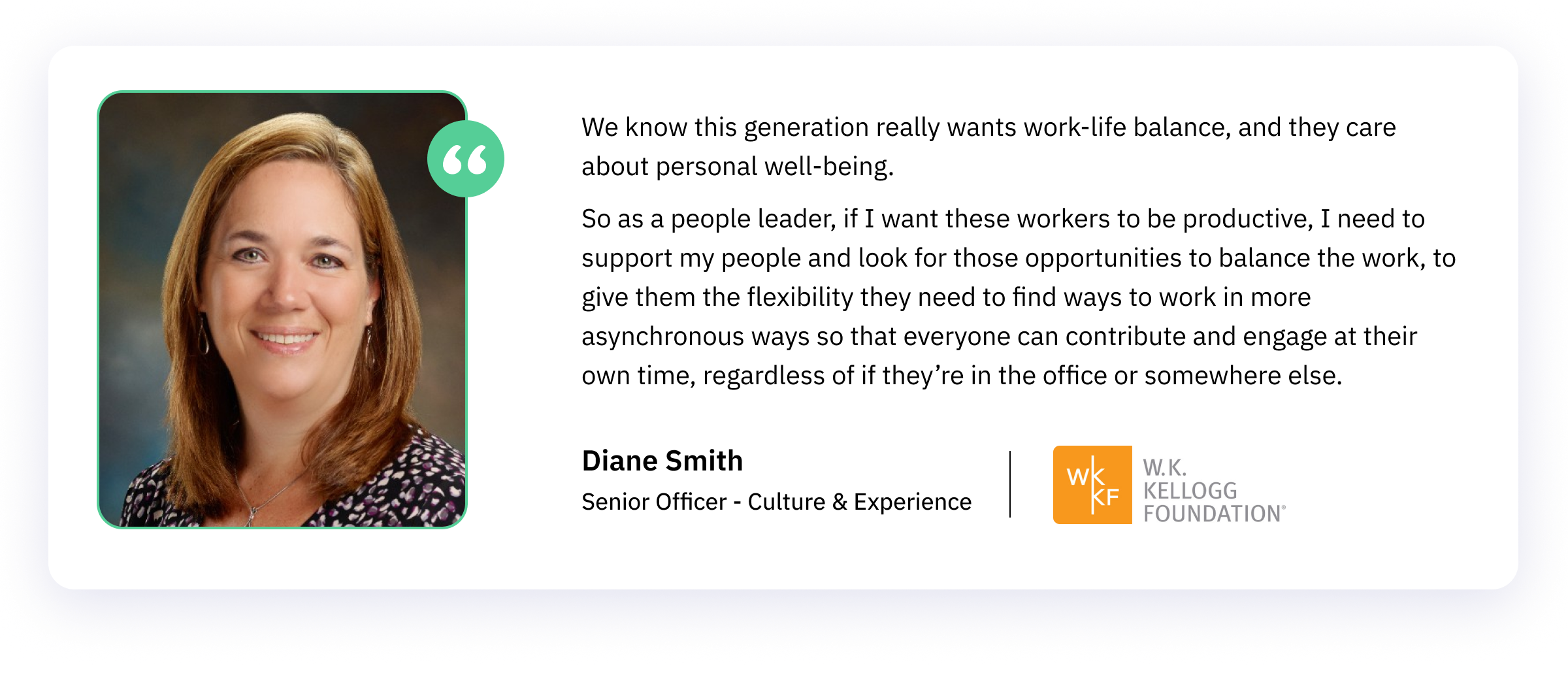45+ Work life balance survey questions: Measure workplace engagement

It is a well-known fact that bosses, in general, are impressed by productive employees—the ones who value the company’s time and effort to make the world a better place by making a great product or service. Smart employees are aware of this and try their best to be their productive selves at the workplace. They know this is the key to a successful career. After all, happy boss, happy life, said everyone in whispers.
Well, the downside to this philosophy in life is that employees are often driven to be their productive best throughout the year. But giving one’s hundred percent all the time is an impossible feat. The illusion that some employees chase by working themselves round the clock without any consideration to their personal crises or physical and emotional health is a major issue, and often overlooked by both leaders and employees.
See how work-life balance survey would look like in CultureMonkey's employee survey tool.
What is work life balance?
Work life balance is the ability to manage one's professional and personal life in an efficient way. It is a state of equilibrium between work and leisure activities and the ability to juggle both with ease. It is important for a person's overall well-being, as it helps to reduce stress, increase productivity, and improve relationships with family and friends.
Work life balance has become increasingly important in today’s world as the demands of both work and personal life have grown. With the rise of technology, people are now able to work and stay connected with their family and friends wherever they go. This has made it much easier to juggle both work and leisure activities, but it has also increased the expectation of being “on” all the time.
As technology continues to evolve, so does the idea of work life balance. This generation prefers to prioritize flexibility in their lives, allowing them to work and play with equal priority. This means that they are more likely to take advantage of remote work options, flexible schedules, and taking time off for self-care activities.
The concept of work life balance is expanding to include more than just work and leisure. People are now looking for more balance in their physical, mental, and emotional health and their relationships with loved ones. This means that people are now paying more attention to things like nutrition, exercise, mental health, and relationships.
The challenge now is finding the time and energy to manage all these different aspects of life. This means it is important to be mindful of how much time is spent on work, leisure activities, and self-care. It is also important to prioritize these activities in order to ensure that all aspects of life are being taken care of.
Why is work life balance important?
The concept of work life balance has been a major concern for employers and employees for many years. As technology continues to evolve, the need to maintain a healthy balance between work and personal life has never been more important. An unbalanced work life dynamic can have a detrimental impact on employees from different generations.

- Gen Z, the newest entrants to the workforce, are characterized by their digital fluency and ambition. Raised in a world of constant connectivity, they crave work-life balance that integrates technology seamlessly. Their desire for flexible schedules and tech-friendly environments stems from valuing personal time. For Gen Z, work-life equilibrium isn't just a preference – it's a necessity to avoid burnout and foster productivity.
- Millennials, also known as Gen Y, are now the largest generation in the workforce. As digital natives, they are used to having access to technology and expect to incorporate it into their work life balance. They prioritize their personal lives, requiring flexible working hours and freedom to use their devices at work. Without these, they can become stressed and burned out.
- Generation Xers, or Gen X, prioritize their career and often put family and other responsibilities on the back burner. They are used to a work life balance and need a sense of control and autonomy over their work. They may become frustrated if they can’t achieve the same balance they had before they entered the workforce.
- Baby Boomers, or Gen B, are the oldest generation in the workforce. They grew up in a time when technology wasn’t as prevalent, so they are used to having more time to dedicate to their personal event. They may feel overwhelmed if their work life balance is disrupted. They may also feel a sense of guilt if they are not able to dedicate enough time to their families.
So it is essential for employers to ensure that their employees have a healthy and balanced work life dynamic. This will help to ensure that their employees are happy and productive and that their businesses remain competitive and successful.
Employers should create policies that accommodate their employees' different needs and expectations, regardless of their generation. This will help ensure everyone feels valued and can achieve a good work life balance.
Upping the balance game
Being productive is great but running after hyper-productivity isn’t. All work and no play makes Jack a dull boy. Let us tell you why.
When employees disregard their physical and emotional needs to scale the career ladder, it almost always backfires. It not only impacts their overall well-being but also their career. Yes, working round the clock without any concern for our needs is extremely harmful. When we lead an imbalanced life, our productivity levels do not surge. In fact, they tend to lower gradually. Not just that, our creativity suffers too.
So, when we are working insane hours every week trying to reach our goals, we are actually draining ourselves completely. We shove ourselves so much into our work that it leads to a number of problems such as:
- Increased levels of irritation and anxiety
- No interest in social interaction
- Loss of emotional hygiene
- Screen fatigue
- Lack of personal growth
These are just a few problems that do not work in your favor when being hyper-productive. When we don’t have a work-life balance, we can never really give our best to our company even if we want to. Burnout can be a real challenge that not only handicaps our work life but also our personal lives.
Lest the balance is lost
As we have hinted earlier, work-life balance does make a happier and balanced individual. And the more balanced an individual is, the happier an employee is. It’s science!
And we got evidence to prove it. In 2019, a monster.com survey revealed that more than half of India’s working professionals fail to achieve work-life balance. Yes, around 60 percent of Indians admitted that their professional lives kept on intruding into their personal lives. The rate was of course higher in metropolitan cities when compared to non-metros. These individuals complained of various physical ailments as well as an impact on their personal relationships, commitments, etc.
But according to a report by Statista, India is in a better position when compared to the U.S. and UK. In fact, the Dutch enjoy the best work-life balance with a score of 9.5 out of 10 followed by the Italians and the Danish.
“For an organization, enabling employees to maintain a work-life balance is important because it stimulates both employee engagement as well as employee retention.”
Recent times have witnessed a major shift in terms of employee behavior. Educated millennials are now looking for jobs that offer a better work-life balance than their current companies. The above-mentioned statistics are dark reminders of burnout and work-induced severe stress.
People have realized the ill effects of working long hours and having stressful jobs. Bigger packages are no more traded for an employee's well-being. According to a Gallup report, How Millennials Want to Work and Live, more and more millennials keep switching jobs searching for better work environments and company culture.
Leaders at many young startups have now started understanding the employee psychology and have begun emphasising the importance of a more flexible and hybrid culture that allows employees a better chance to enjoy an improved work-life balance.
Benefits of work-life balance

A good work life balance benefits are immense and can help employees in many ways. Here are some key ways work life balance can help employees:
- Improved mental health: Work life balance reduces stress and anxiety, leading to improved mental health. It also reduces the risk of employee burnout, depression, and job dissatisfaction.
- Improved physical health: Work life balance helps improve overall physical health by reducing stress, which can have a negative effect on physical health. Stress can contribute to conditions such as headaches, high blood pressure, heart disease, and other ailments.
- Increased productivity: When employees are able to balance their work and personal lives, they are more likely to be productive at work. This is due to the fact that they are not distracted by their personal lives and can focus on their job duties.
- Improved quality of life: Work life balance allows employees to enjoy a better quality of life. This is because they are able to spend more time with family and friends, which can lead to increased satisfaction, where employees don't have to sacrifice sleep.
- Increased job satisfaction: When employees are able to balance their work and personal lives, they are more likely to be satisfied with their jobs. This is due to the fact that they are able to enjoy their job duties while still having time to pursue personal interests.
- Increased sense of achievement: Work life balance can lead to a sense of accomplishment as employees are able to accomplish both their work and personal goals. This can lead to increased job satisfaction and improved quality of life.
- Increased creativity: When employees are able to balance their work and personal lives, they are more likely to be creative. This is due to the fact that they are not mentally exhausted and can think more clearly.
- Reduced absenteeism: Work life balance can help reduce absenteeism. This is because employees are less likely to take time off for personal reasons when they are able to balance their work and personal lives.
- Enhanced work engagement: Achieving work-life balance fuels employees' engagement levels. With reduced stress among employees, they can invest more energy and passion into their tasks, fostering a stronger connection to their roles and responsibilities.
- Better interpersonal relationships: Work-life balance nurtures healthier relationships, not only within the workplace but also outside it. Employees can dedicate quality time to loved ones, creating a positive ripple effect on their overall happiness.
- Sharper decision-making: Balanced individuals tend to make better decisions. Work-life equilibrium ensures employees approach problems with a clear mind, enabling them to analyze situations more objectively and arrive at well-informed choices.
- Skill diversification: A balanced schedule offers the opportunity to explore new skills and hobbies. This diversification not only adds value to an employee's life but can also lead to unexpected synergies that benefit their professional growth.
- Heightened time management: Striking a balance hones time management skills. Juggling work tasks and personal responsibilities necessitates efficient planning, translating to improved organizational abilities in all aspects of life.
- Longevity in careers: Employees who maintain a work-life balance are likely to enjoy longer, more sustainable careers. Avoiding burnout and maintaining enthusiasm can contribute to a consistent upward trajectory within an organization.
- Resilience to challenges: A balanced lifestyle builds resilience. Employees adept at managing their work and personal lives are often better equipped to handle unforeseen challenges, demonstrating adaptability and grace under pressure.
- Better teamwork: Employees who have a good work-life balance are often more effective team players. They bring a positive attitude to the workplace, collaborate more efficiently, and support their colleagues, fostering a more cohesive and productive work environment.
- Improved focus: A well-balanced life enhances an employee's ability to concentrate. When personal stressors are managed, employees can direct their full attention to work tasks, resulting in higher quality outputs and fewer errors.
- Higher retention rates: Companies that support work-life balance often see higher retention rates. Employees are more likely to stay with a company that values their well-being, reducing turnover costs and retaining institutional knowledge.
- Stronger employer brand: Organizations known for promoting work-life balance tend to attract top talent. A reputation for supporting employees' personal lives can make a company more appealing to job seekers, enhancing its ability to recruit skilled professionals.
- Enhanced innovation: A balanced work-life dynamic can lead to greater innovation. Employees who are not overworked have the mental space to think creatively and bring fresh ideas to the table, driving the company forward.
- Improved employee morale: Work-life balance boosts overall morale. Employees feel more valued and respected when their personal needs are considered, leading to a more positive and motivating work atmosphere.
Employee engagement and work life balance

Employee engagement and work-life balance share a symbiotic relationship that profoundly influences workplace dynamics. When employees experience a healthy work-life balance, their engagement levels often soar. This connection is vital because engaged employees are more likely to invest their energy, creativity, and dedication into their roles.
An employee who feels that their personal time is respected and their well-being is valued by the organization is likely to reciprocate with higher levels of engagement. Conversely, a lack of work-life balance can lead to burnout, decreased job satisfaction, and disengagement. This intricate interplay highlights the significance of fostering an environment that nurtures both aspects.
When an organization promotes work-life balance through flexible scheduling, supportive policies, and a culture that respects personal boundaries, it not only improves physical and mental health and overall satisfaction but also cultivates a workforce that is more engaged. Engaged employees are likelier to stay with the company, contribute innovative ideas, and collaborate effectively.
Organizations can formulate strategies that elevate both areas by acknowledging the link between work-life balance and employee engagement. Employees who feel empowered to achieve balance are better positioned to bring their best selves to work.
What are the major challenges of work-life balance?

Navigating these hurdles requires a proactive approach and a resilient mindset. Here are eight of the major challenges individuals often encounter in their quest for work-life balance:
1. Overlapping boundaries
One of the most common challenges is the blurring of boundaries between work and personal life. With the rise of remote work and constant connectivity, it becomes difficult to disconnect from work-related tasks during personal time. The pressure to be available at all times can lead to burnout and a sense of being constantly "on."
2. Time management struggles
Balancing work tasks, personal responsibilities, and self-care activities can be a juggling act. Poor work life balance i.e. time management can result in increased stress, missed deadlines, and a feeling of being overwhelmed. Striking the right balance requires efficient planning and prioritization.
3. Guilt and expectations
Many individuals struggle with guilt when focusing on one area over the other. While at work, they might feel guilty about not spending enough time with family, and vice versa. Societal and self-imposed expectations can create internal conflict and hinder the ability to fully engage in either realm.
4. High workload and demands
Heavy workloads, tight deadlines, and demanding job responsibilities can consume a significant portion of one's time and energy. When work demands are excessive, finding time for personal pursuits becomes a challenge, leading to a lopsided work-life balance.
5. Career advancement pressure
Ambitious individuals might find themselves sacrificing personal time to advance their careers. The pressure to constantly achieve, climb the corporate ladder, or meet aggressive targets can tip the balance heavily toward work, leaving little room for leisure or family activities.
6. Impact on relationships
Maintaining work-life balance is crucial for nurturing healthy relationships. However, excessive work commitments can strain relationships with family, friends, and significant others. Lack of quality time and emotional availability can lead to conflicts and feelings of neglect.
7. Technological intrusion
While technology facilitates work flexibility, it can also encroach on personal time. The constant barrage of emails, notifications, and work-related messages during off-hours can disrupt relaxation and prevent individuals from fully unplugging.
8. Changing life stages
Work-life balance challenges can shift as life stages change. Young professionals might focus on building their careers, while parents might struggle to balance work with family obligations. Each life stage presents unique challenges that require adaptive strategies.
Employee work-life balance questionnaire and mental health

The Employee Work-Life Balance Questionnaire is a powerful tool that not only delves into an individual's approach to balancing professional and personal commitments but also holds implications for their mental health. As the demands of modern work environments increase, understanding how work-life balance impacts mental well-being becomes crucial.
This questionnaire can uncover whether employees feel supported in maintaining this equilibrium or if excessive work demands are affecting their mental health. By asking about stress levels, burnout, and overall mental well-being, organizations gain insights into potential areas of concern.
Furthermore, the questionnaire's results can guide organizations in tailoring resources and support systems to address mental health challenges. It opens avenues for discussing coping mechanisms, fostering open communication, and implementing policies that prioritize both productivity and mental well-being.
In a world where the boundary between work and personal life can blur, assessing work-life balance isn't just about time allocation; it's a step towards safeguarding employees' mental health. The insights garnered from this questionnaire facilitate a holistic approach to employee well-being, ultimately benefiting both individuals and the organization as a whole.
What is the most common cause of poor work-life balance?
Poor work-life balance is a prevalent issue affecting many employees across various industries. Understanding its root cause is essential for creating effective strategies to improve work life balance. The most common cause of poor work-life balance is excessive workload.
- Unrealistic deadlines: Tight deadlines create pressure, forcing employees to work longer hours to meet expectations, often at the expense of personal time.
- High job demands: Jobs that require constant multitasking and handling multiple projects simultaneously can overwhelm employees, leaving little room for relaxation and personal activities.
- Lack of delegation: When leaders fail to delegate tasks appropriately, employees may end up with more responsibilities than they can manage, leading to extended working hours.
- Inadequate staffing: Insufficient staffing levels mean existing employees must cover additional duties, increasing their workload and reducing their ability to maintain a healthy work-life balance.
- Poor time management: Employees struggling with time management often find themselves working late to complete tasks, negatively impacting their personal lives.
- Constant connectivity: The expectation to be always available through emails and messaging apps blurs the boundaries between work and personal time, contributing to poor work-life balance.
- High performance expectations: Organizations with high performance standards can pressure employees to overwork to meet these expectations, sacrificing personal time.
- Lack of flexibility: Rigid work schedules that do not accommodate personal needs can make it difficult for employees to balance work with other life responsibilities.
- Inadequate support systems: Without adequate support from management or colleagues, employees may struggle to manage their workload effectively.
- Competitive work culture: A competitive work environment can encourage long hours and constant availability, undermining work-life balance.
- Poor organizational structure: Inefficient processes and unclear job roles can lead to confusion and additional work, increasing the burden on employees.
- Personal perfectionism: Employees with perfectionist tendencies may overwork to ensure tasks are completed to their high standards, impacting their personal lives.
- Economic pressures: In times of economic uncertainty, employees may work longer hours to secure their jobs, compromising their work-life balance.
How to improve your work life balance?
A healthy work life balance helps ensure that your professional and personal lives are balanced and that neither takes precedence over the other. However, achieving a good work life balance can be difficult, especially if juggling multiple obligations.
Fortunately, there are several steps you can take to improve your work life balance.
- Prioritize: Take the time to prioritize your life and work tasks. Make a list of what needs to be accomplished and divide it into sections for work and home. That way, you can focus on the most important tasks first and ensure you're taking care of your professional and personal responsibilities.
- Set boundaries: It's important to set boundaries between your work and home life. Create a schedule and stick to it. Let your co-workers know when you're available and when you're not. Set realistic expectations for yourself and your team, and don't be afraid to say no if something isn't feasible.
- Take breaks: Regular breaks throughout the day are essential for maintaining a healthy work life balance. Get up and walk around for a few minutes, or take a short break to have a snack or read a book. This will help you stay focused and productive throughout the day.
- Limit distractions: It can be difficult to focus when there are a lot of distractions around you. Take steps to limit the number of distractions you have to deal with, such as turning off your phone, closing your email, and disconnecting from social media.
- Make time for yourself: Make sure to take some time for yourself each day. Whether going for a walk, reading a book, or getting a massage, take some time to relax and recharge.
- Delegate: Don't be afraid to delegate tasks to others. You don't have to do everything yourself. Delegating tasks to others can help you free up time to focus on the things that really matter.
How do you measure a good work life balance?

Measuring work life balance can help employers ensure their employees are engaged, motivated, and productive. Employers can measure work life balance by evaluating how much time employees spend on work, the quality of work they are producing, and their engagement level towards their work.
Employers should assess how much time employees can spend on personal activities such as family time, leisure activities, or vacations while also evaluating their employees’ emotional and physical well-being and ensuring that their employees are not suffering from stress or burnout.
Employees can measure their work life balance by assessing their satisfaction with their job and personal life. Employees should evaluate how much time they spend on work related tasks and how much time they can spend on personal and leisure activities.
Here are a few employee surveys that employers can use to measure a good work life balance for their employees:-
Employee engagement survey:
Employee engagement surveys measure how employees feel about their work, job satisfaction, and relationship with their managers and colleagues. The survey should contain questions about job satisfaction, job security, recognition and reward, learning and development, communication, and other areas of job satisfaction. The employee engagement survey can help employers understand how engaged employees are with their job and the organization as a whole.
Gathering insights through employee engagement surveys is like peering into the heart of an organization. By probing deeper into aspects such as communication effectiveness, professional growth opportunities, and collaboration dynamics, employers can unlock valuable information that fuels actionable strategies for fostering employee commitment and organizational success.
Employee satisfaction survey
This type of survey measures employees' overall job satisfaction. It helps employers understand how their employees view the organization, their job, and the workplace culture. So, in your next employee satisfaction survey, you should focus on areas such as job satisfaction, job security, job performance, overall work experience, and their opinion of their supervisors.
Employee satisfaction surveys provide a canvas for candid feedback, helping organizations adapt and evolve. Diving deeper into areas like job security and performance assessment allows leaders to constructively fine-tune policies and practices, nurturing an environment where content employees become champions of thriving workplace culture.
Mental health survey
Mental health surveys measure the mental well-being of employees. Questions should focus on stress, burnout, depression, and other mental health issues. This employee survey can help employers identify any mental health issues that may be affecting their employees and provide guidance on how to support them.
Mental health surveys serve as a bridge to addressing the invisible struggles that employees might face. By inquiring about stress levels, emotional resilience, and overall mental health, organizations demonstrate care and gain insights to shape policies that foster well-being, reduce absenteeism and enhance productivity.
Manager effectiveness survey
Manager effectiveness surveys measure employees' feelings about their direct manager. The survey should contain questions about leadership, communication, feedback, trust, and other areas that affect employees’ opinions of their manager. This survey can help employers understand how employees view their managers and identify any areas of improvement.
Manager effectiveness surveys provide a lens into the crucial manager-employee dynamic. Beyond the surface, these surveys delve into leadership styles, feedback mechanisms, and communication proficiency, enabling organizations to fine-tune managerial approaches and create an atmosphere of mutual respect and collaboration.
Work environment surveys
Work environment surveys measure employees' feelings about their work environment. Questions should focus on the physical environment, atmosphere, and resources available to employees. This survey can help employers understand how employees view the workspace and identify any areas of improvement.
Work environment surveys are like blueprints for creating conducive workspaces. By inquiring about the physical environment and atmosphere, employers can mold the workplace into a vibrant, comfortable setting that bolsters productivity and fosters a positive sense of belonging among employees.
Pulse survey
Pulse surveys measure employees’ current sentiments about the workplace. The survey questions focus on job satisfaction, engagement, morale, and other areas that affect employees’ opinions of their job. This employee pulse survey can help employers understand how employees feel in the moment and identify any areas of improvement.
Pulse surveys act as the heartbeat of organizational sentiment, providing real-time insights. By capturing instantaneous feelings on job satisfaction and morale, organizations can respond swiftly to challenges and opportunities, demonstrating a commitment to continuous improvement and employee well-being.
Empowerment surveys
These help measure how empowered employees feel in their job. The survey often focuses on autonomy, decision-making, and other areas of employee empowerment. This survey can help employers understand how empowered employees feel in their roles and identify any areas of improvement.
Empowerment surveys offer a compass for cultivating a culture of ownership. By exploring employees' sense of autonomy and involvement in decision-making, organizations can nurture an empowered workforce that takes initiative, drives innovation, and contributes to the company's growth journey.
What is worklife balance questionnaire?

A Work-life balance questionnaire is a structured set of inquiries designed to explore an individual's perspective on balancing their professional and personal life harmoniously. This questionnaire delves deeper into their beliefs, strategies, and preferences related to maintaining equilibrium while managing work responsibilities and personal commitments.
Through carefully curated questions, this tool uncovers candidates' approaches to stress management, time allocation, and their understanding of the importance of downtime.
It also delves into their alignment with flexible work arrangements, technology usage boundaries, and the level of support they seek from their employer to achieve this balance.
The work-life balance questionnaire goes beyond mere skills assessment, providing a window into candidates' emotional resilience, adaptability, and long-term vision for maintaining their well-being.
By understanding their perspectives on achieving balance, organizations can make more informed hiring decisions and create an environment that supports employees in their pursuit of both professional success and personal fulfillment.
How do you create good interview questions about work life balance?

Crafting insightful questions helps ensure that the right candidates are not only skilled but also aligned with your organization's commitment to a balanced professional and personal life. Here's how you can do it:
Holistic vision:
Ask candidates to describe their ideal work-life balance. This offers insights into their expectations and priorities, helping you understand if they resonate with your company's values.
Prioritization techniques:
Inquire about how candidates manage their tasks and commitments outside of work. Their ability to prioritize indicates whether they can maintain equilibrium, even during demanding periods.
Stress management:
Discuss how candidates handle stress and pressure. Their coping mechanisms shed light on their emotional resilience and whether they can handle challenges without sacrificing their well-being.
Flexibility alignment:
Explore their opinion on flexible work arrangements. Do they see these options as a beneficial solution, or are they more comfortable with traditional structures? This uncovers whether their expectations align with your company's approach.
Learning from past experiences:
Ask about a time when they faced conflicting demands between work and personal life. Their response reveals their problem-solving skills, adaptability, and how they learn from these situations.
Technology boundaries:
Discuss their relationship with technology outside of working hours. Do they feel the need to always be connected, or do they believe in setting boundaries? This offers insights into their ability to disconnect and recharge.
Support systems:
Inquire about the kind of support they expect from their employer in maintaining work-life balance. This unveils their communication preferences and how well they align with the resources your company provides.
Long-term sustainability:
Ask candidates how they envision sustaining a healthy work-life balance in the long term. Their answer will reflect their commitment to maintaining equilibrium even as their responsibilities evolve.
How do you manage work-life balance questions?
managing work-life balance is a dynamic skill that requires conscious effort and effective strategies. Here's how individuals can navigate this balancing act:
1. Prioritize tasks:
Identify tasks based on urgency and importance. Allocating time to high-priority tasks ensures that essential work is completed without compromising personal time.
2. Set boundaries:
Establish clear boundaries between work and personal life. Define specific work hours and refrain from checking emails or taking work-related calls outside those hours.
3. Time blocking:
Segment your day into focused blocks of time for work tasks, breaks, and personal activities. This structured approach enhances productivity and leaves room for relaxation.
4. Learn to delegate:
Recognize when to delegate tasks to colleagues or team members. Delegation reduces overwhelm and empowers others while freeing you to concentrate on critical responsibilities.
5. Utilize technology mindfully:
While technology connects us, it can also blur boundaries. Set designated times for checking emails and messages to prevent constant interruptions during personal time.
6. Practice self-care:
Prioritize self-care activities like exercise, hobbies, and spending time with loved ones. These rejuvenating moments fuel your energy and overall well-being.
7. Effective planning:
Plan your week ahead, both professionally and personally. Allocate time for work tasks, family commitments, and relaxation to maintain a sense of control.
8. Embrace flexibility:
Embrace flexible work arrangements, if available, to tailor your schedule to your peak productivity hours and personal commitments.
9. Learn to say no:
Avoid overcommitting. Politely decline additional tasks when your plate is already full to avoid burnout.
10. Regular breaks:
Incorporate short breaks during the workday to recharge. Even a brief walk or a few minutes of deep breathing can refresh your mind.
11. Reflect and adjust:
Regularly assess your work-life balance. If you find that one area is overpowering the other, make adjustments to restore equilibrium.
12. Communicate openly:
Discuss your work-life balance needs with your supervisor and colleagues. Open communication fosters understanding and support.
Work life balance statistics that you should know about
- According to the Organisation for Economic Co-operation and Development (OECD), the proportion of American employees working long hours exceeds the OECD average by ten percent.
- Microsoft's findings reveal that since the pandemic, there has been a significant shift in employee priorities. Health and wellbeing now take precedence over work for 53% of employees.
- Health Careers' data highlights that a substantial 48% of Americans self-identify as workaholics. Furthermore, a considerable number of U.S. workers, numbering in the thousands, invest more than four hours per week in unpaid work. Similarly, they allocate an equal amount of time to work-related concerns.
- Deloitte's work-life balance survey, conducted with 1,000 respondents, underscores the prevalence of burnout in the workplace. A substantial 77% of participants reported experiencing burnout at least once in their current jobs.
Surveys can help gauge the work-life balance of remote employees
Even though a growing number of leaders are accommodating the idea of encouraging a work-life balance, it remains a difficult job. It is not easy for leaders to identify whether employees can maintain a work-life balance. It’s quite easy to lose oneself in meetings, daily tasks, and emails often forgetting to check in on one’s employees. This has been even more difficult with the onset of the pandemic.
Teams that used to brainstorm ideas together and share lunches together have to work remotely now. While this has been a boon for many reasons, a lot of employees admit work from home has taken a toll on their work-life balance. And it’s quite difficult for leaders to measure the temperament of each of their employees via a 30-minute video call while trying to finish a high-profile project.
It is under such situations that surveys come in handy. Employee surveys are basically questionnaires that are designed to gauge various factors in an employee’s life cycle in the company. The surveys are generally used to track different metrics like job satisfaction, employee wellness, etc.
CultureMonkey, for instance, makes it extremely easy for leaders and HR professionals to monitor their workforce by providing an entire library of surveys. In case the leader or HR member wants to check the work-life balance in their employees’ lives, they can customize surveys just for that or use the template dedicated to work-life balance from the vast survey template library offered by the platform.
45+ work-life balance survey questions that you should ask in 2024
Curating a list of questions for a survey that is specifically dedicated to a particular driver of engagement, say work-life balance, can be cumbersome if one does not have access to an employee engagement platform. To make things easy, we have listed down 45+ work-life survey questions that leaders and HR professionals can ask their employees.
- How often do you work beyond your specified working hours?
- Are you satisfied with your current work-life balance?
- Can you cope with the current workload assigned to you?
- Does your work schedule allow you to spend quality time with your friends and family?
- Are you suffering from burnout or work-related illnesses?
- Does your manager/team leader respect your work-life balance?
- Do you have enough time to destress from your work schedule?
- Have you ever disregarded your personal commitments due to work?
- Do you have time to pursue personal interests and hobbies?
- How much time do you spend with your friends and family on a daily basis?
- Do you think your teammates have a healthy work-life balance?
- Can you set strict boundaries between work and life?
- Do you need extra help to complete your work tasks?
- Is the company’s overall culture empathetic to your needs?
- How often have you worked during vacations?
- How often do you take breaks throughout the day to move or exercise?
- Do you practice self-care and maintain your physical health?
- How do you prioritize physical activity in your daily routine?
- On a scale from 1 to 10, how would you rate your current mental well-being?
- How often do you take breaks from work to reduce stress and anxiety?
- Do you feel supported by your employer in maintaining positive mental health?
- Do you think your workplace needs changes to help promote emotional well-being?
- Do you find that your emotional well-being is taken into account when making decisions and setting goals at work?
- How could your employer better support your professional development goals?
- Have you taken advantage of any professional development opportunities this past year?
- How often do you feel socially connected with the people around you?
- Are there barriers preventing you from having a healthy social life?
- How often do you feel overwhelmed by your work responsibilities?
- Do you feel that you have a good balance between your work and personal life on weekends?
- Is your workload evenly distributed throughout the week?
- How often do you work on weekends?
- Are you able to disconnect from work communications outside of working hours?
- Do you feel pressured to work overtime?
- How do you manage your time between work and personal activities?
- Do you think you have a supportive network of colleagues?
- How satisfied are you with the company’s flexible working policies?
- Do you feel comfortable discussing work-life balance issues with your supervisor?
- How often do you feel you need a mental health day?
- Do you have access to resources that help you manage work-related stress?
- How do you balance work demands with family or childcare responsibilities?
- Are there specific times of the year when your work-life balance is more difficult to manage?
- Do you have enough vacation days to recharge?
- How often do you use your vacation days?
- Are there any company policies that you believe negatively impact your work-life balance?
- Do you feel that your personal life is respected by your employer?
- How often do you check work emails or messages outside of office hours?
- Do you feel your job allows for enough flexibility to handle personal emergencies?
- How effective are the current work-from-home policies in supporting your work-life balance?
- Are you satisfied with the amount of time you can dedicate to your hobbies and personal interests?
Choose a survey for your company
It is important to remember that every company functions differently because no founder or leader functions the same. That is why policies and culture vary from company to company.
Leaders (at all levels) must remember that employee engagement survey questionnaires must be customized as per their company’s needs while pursuing an employee-first approach because the purpose of conducting surveys is to understand the employees while offering actionable solutions for the growth of the employees as well as the company.
Modern employee survey tools like CultureMonkey facilitates people leaders like you to listen, analyze, and act on work life balance concerns of your employees with ease to ensure that your organization has greater retention rates.
So, without further delay, ensure your employees balance their work and personal life through CultureMonkey.
FAQs
What is work-life balance and why is it important?
Work-life balance refers to the equilibrium between professional and personal commitments. It's crucial as it promotes mental well-being, reduces stress, and enhances overall quality of life. Striking this balance helps prevent burnout, fosters productivity, and allows individuals to enjoy fulfilling personal lives alongside their careers.
How can I achieve a better work-life balance?
Achieving a better work-life balance involves setting clear boundaries, prioritizing tasks, and practicing effective time management. Allocate time for work, hobbies, and family, and disconnect from work during personal hours. Regularly reassess and adjust your schedule to maintain a sustainable equilibrium.
What are some strategies for balancing work and personal life?
To balance work and personal life, consider time-blocking, delegating tasks, and embracing flexibility. Create a structured schedule that accommodates both professional commitments and personal interests. Effective communication with colleagues and employers about your boundaries can also contribute to a successful balance.
How do I assess my current work-life balance?
Assessing your work-life balance involves evaluating the amount of time and energy dedicated to work versus personal activities. Reflect on your stress levels, time spent with loved ones, and the impact of your job on your overall well-being. Adjust your routine as needed to prioritize self-care and relaxation.
What are some work-life balance interview questions for candidates?
Work-life balance interview questions for candidates could include queries about how they manage their time, handle stress, and prioritize personal commitments. Their opinions on flexible work arrangements and boundaries reveal their approach to maintaining equilibrium. Assessing their alignment with your company's values ensures a harmonious fit.
What is an unhealthy work-life balance?
An unhealthy work-life balance occurs when an individual's work demands consistently overshadow personal time, leading to chronic stress, burnout, and a decline in overall well-being. This imbalance can manifest as long working hours, lack of time for family and leisure, and the inability to disconnect from responsibilities. Such a scenario not only impacts physical and mental health but also reduces productivity.
What are the factors determining work-life balance?
Several factors determine work-life balance, including workload management, organizational culture, and the availability of flexible working arrangements. Effective time management and the ability to set clear boundaries between work and personal life are crucial. Support from employers in terms of reasonable expectations, adequate resources, and a supportive work environment also play significant roles.



